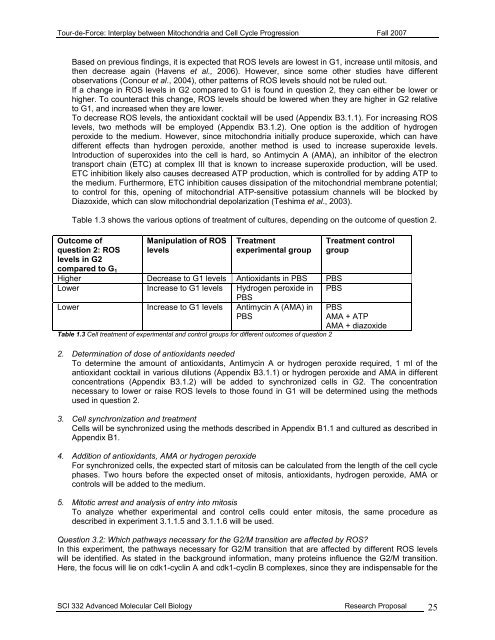Tour-de-Force
Tour-de-Force
Tour-de-Force
Create successful ePaper yourself
Turn your PDF publications into a flip-book with our unique Google optimized e-Paper software.
<strong>Tour</strong>-<strong>de</strong>-<strong>Force</strong>: Interplay between Mitochondria and Cell Cycle Progression Fall 2007Based on previous findings, it is expected that ROS levels are lowest in G1, increase until mitosis, andthen <strong>de</strong>crease again (Havens et al., 2006). However, since some other studies have differentobservations (Conour et al., 2004), other patterns of ROS levels should not be ruled out.If a change in ROS levels in G2 compared to G1 is found in question 2, they can either be lower orhigher. To counteract this change, ROS levels should be lowered when they are higher in G2 relativeto G1, and increased when they are lower.To <strong>de</strong>crease ROS levels, the antioxidant cocktail will be used (Appendix B3.1.1). For increasing ROSlevels, two methods will be employed (Appendix B3.1.2). One option is the addition of hydrogenperoxi<strong>de</strong> to the medium. However, since mitochondria initially produce superoxi<strong>de</strong>, which can havedifferent effects than hydrogen peroxi<strong>de</strong>, another method is used to increase superoxi<strong>de</strong> levels.Introduction of superoxi<strong>de</strong>s into the cell is hard, so Antimycin A (AMA), an inhibitor of the electrontransport chain (ETC) at complex III that is known to increase superoxi<strong>de</strong> production, will be used.ETC inhibition likely also causes <strong>de</strong>creased ATP production, which is controlled for by adding ATP tothe medium. Furthermore, ETC inhibition causes dissipation of the mitochondrial membrane potential;to control for this, opening of mitochondrial ATP-sensitive potassium channels will be blocked byDiazoxi<strong>de</strong>, which can slow mitochondrial <strong>de</strong>polarization (Teshima et al., 2003).Table 1.3 shows the various options of treatment of cultures, <strong>de</strong>pending on the outcome of question 2.Outcome ofquestion 2: ROSlevels in G2compared to G 1Manipulation of ROSlevelsTreatmentexperimental groupHigher Decrease to G1 levels Antioxidants in PBS PBSLower Increase to G1 levels Hydrogen peroxi<strong>de</strong> in PBSPBSLower Increase to G1 levels Antimycin A (AMA) inPBSTable 1.3 Cell treatment of experimental and control groups for different outcomes of question 2Treatment controlgroupPBSAMA + ATPAMA + diazoxi<strong>de</strong>2. Determination of dose of antioxidants nee<strong>de</strong>dTo <strong>de</strong>termine the amount of antioxidants, Antimycin A or hydrogen peroxi<strong>de</strong> required, 1 ml of theantioxidant cocktail in various dilutions (Appendix B3.1.1) or hydrogen peroxi<strong>de</strong> and AMA in differentconcentrations (Appendix B3.1.2) will be ad<strong>de</strong>d to synchronized cells in G2. The concentrationnecessary to lower or raise ROS levels to those found in G1 will be <strong>de</strong>termined using the methodsused in question 2.3. Cell synchronization and treatmentCells will be synchronized using the methods <strong>de</strong>scribed in Appendix B1.1 and cultured as <strong>de</strong>scribed inAppendix B1.4. Addition of antioxidants, AMA or hydrogen peroxi<strong>de</strong>For synchronized cells, the expected start of mitosis can be calculated from the length of the cell cyclephases. Two hours before the expected onset of mitosis, antioxidants, hydrogen peroxi<strong>de</strong>, AMA orcontrols will be ad<strong>de</strong>d to the medium.5. Mitotic arrest and analysis of entry into mitosisTo analyze whether experimental and control cells could enter mitosis, the same procedure as<strong>de</strong>scribed in experiment 3.1.1.5 and 3.1.1.6 will be used.Question 3.2: Which pathways necessary for the G2/M transition are affected by ROS?In this experiment, the pathways necessary for G2/M transition that are affected by different ROS levelswill be i<strong>de</strong>ntified. As stated in the background information, many proteins influence the G2/M transition.Here, the focus will lie on cdk1-cyclin A and cdk1-cyclin B complexes, since they are indispensable for theSCI 332 Advanced Molecular Cell Biology Research Proposal 25
















